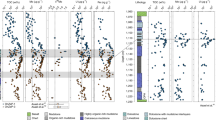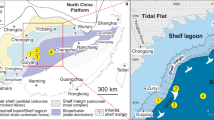Abstract
Oxygenation of the Earth’s surface is increasingly thought to have occurred in two steps. The first step, which occurred ∼2,300 million years (Myr) ago, involved a significant increase in atmospheric oxygen concentrations and oxygenation of the surface ocean1,2. A further increase in atmospheric oxygen appears to have taken place during the late Neoproterozoic period3,4 (∼800–542 Myr ago). This increase may have stimulated the evolution of macroscopic multicellular animals and the subsequent radiation of calcified invertebrates4,5, and may have led to oxygenation of the deep ocean6. However, the nature and timing of Neoproterozoic oxidation remain uncertain. Here we present high-resolution carbon isotope and sulphur isotope records from the Huqf Supergroup, Sultanate of Oman, that cover most of the Ediacaran period (∼635 to ∼548 Myr ago). These records indicate that the ocean became increasingly oxygenated after the end of the Marinoan glaciation, and they allow us to identify three distinct stages of oxidation. When considered in the context of other records from this period7,8,9,10,11,12,13,14,15, our data indicate that certain groups of eukaryotic organisms appeared and diversified during the second and third stages of oxygenation. The second stage corresponds with the Shuram excursion in the carbon isotope record16 and seems to have involved the oxidation of a large reservoir of organic carbon suspended in the deep ocean6, indicating that this event may have had a key role in the evolution of eukaryotic organisms. Our data thus provide new insights into the oxygenation of the Ediacaran ocean and the stepwise restructuring of the carbon6,16,17 and sulphur cycles3,18,19 that occurred during this significant period of Earth’s history.
This is a preview of subscription content, access via your institution
Access options
Subscribe to this journal
Receive 51 print issues and online access
$199.00 per year
only $3.90 per issue
Buy this article
- Purchase on Springer Link
- Instant access to full article PDF
Prices may be subject to local taxes which are calculated during checkout


Similar content being viewed by others
References
Holland, H. D. The Chemical Evolution of the Atmosphere and Oceans (Princeton Univ. Press, Princeton, NJ, 1984)
Bekker, A. et al. Dating the rise of atmospheric oxygen. Nature 427, 117–120 (2004)
Canfield, D. E. & Teske, A. Late Proterozoic rise in atmospheric oxygen concentration inferred from phylogenetic and sulphur-isotope studies. Nature 382, 127–132 (1996)
Des Marais, D. J., Strauss, H., Summons, R. E. & Hayes, J. M. Carbon isotope evidence for the stepwise oxidation of the Proterozoic environment. Nature 359, 605–609 (1992)
Knoll, A. H. & Carroll, S. B. Early animal evolution; emerging views from comparative biology and geology. Science 284, 2129–2137 (1999)
Rothman, D. H., Hayes, J. M. & Summons, R. E. Dynamics of the Neoproterozoic carbon cycle. Proc. Natl Acad. Sci. USA 100, 8124–8129 (2003)
Bowring, S. A., Grotzinger, J. P., Condon, D. J., Ramezani, J. & Newall, M. Geochronologic constraints on the chronostratigraphic framework of the Neoproterozoic Huqf Supergroup, Sultanate of Oman. Am. J. Sci. (in the press).
Grotzinger, J. P., Bowring, S. A., Saylor, B. Z. & Kaufman, A. J. Biostratigraphic and geochronological constraints on early animal evolution. Science 270, 598–604 (1995)
Condon, D. et al. U-Pb Ages from the Neoproterozoic Doushantuo Formation, China. Science 308, 95–98 (2005)
Grey, K. Ediacaran Palynology of Australia Vol. 31 (Association of Australasian Paleontologists, Canberra, 2005)
Martin, M. W. et al. Age of Neoproterozoic bilatarian body and trace fossils, White Sea, Russia: implications for metazoan evolution. Science 288, 841–845 (2000)
Narbonne, G. M. The Ediacara Biota: Neoproterozoic origin of animals and their ecosystems. Annu. Rev. Earth Planet. Sci. 33, 1–22 (2005)
Calver, C. R. Isotope stratigraphy of the Ediacarian (Neoproterozoic III) of the Adelaide Rift Complex, Australia, and the overprint of water column stratification. Precambr. Res. 100, 121–150 (2000)
Corsetti, F. A. & Kaufman, A. J. Stratigraphic investigations of carbon isotope anomalies and Neoproterozoic ice ages in Death Valley, California. Geol. Soc. Am. Bull. 115, 916–932 (2003)
Workman, R. K., Grotzinger, J. P. & Hart, S. R. Constraints on Neoproterozoic ocean chemistry from δ13C and δ11B analyses of carbonates from the Witvlei and Nama Groups, Namibia. Geochim. Cosmochim. Acta 66, 847 (2002)
Burns, S. J. & Matter, A. Carbon isotopic record of the latest Proterozoic from Oman. Eclog. Geol. Helv. 86, 595–607 (1993)
Logan, G. A., Hayes, J. M., Hieshima, G. B. & Summons, R. E. Terminal proterozoic reorganization of biogeochemical cycles. Nature 376, 53–56 (1995)
Canfield, D. E. The evolution of the Earth surface sulfur reservoir. Am. J. Sci. 304, 839–861 (2004)
Hurtgen, M. T. Sulfur cycling in the aftermath of a Neoproterozoic (Marinoan) snowball glaciation: Evidence for a syn-glacial sulfidic deep ocean. Earth Planet. Sci. Lett. 245, 551–570 (2006)
Amthor, J. E. et al. Extinction of Cloudina and Namacalathus at the Precambrian–Cambrian boundary in Oman. Geology 31, 431–434 (2003)
McCarron, G. The Sedimentology and Chemostratigraphy of the Nafun Group, Huqf Supergroup, Oman. Thesis, Univ. Oxford. (2000)
Bowring, S. A., Myrow, P. M., Landing, E. & Ramezani, J. Geochronological contraints on terminal Neoproterozoic events and the rise of Metazoans. Astrobiology 2, 112 (2002)
Le Guerroue, E., Allen, P. A. & Cozzi, A. Chemostratigraphic and sedimentological framework of the largest negative carbon isotopic excursion in Earth history: The Neoproterozoic Shuram Formation (Nafun Group, Oman). Precambr. Res. 146, 68–92 (2006)
Melezhik, V. A., Fallick, A. E. & Pokrovsky, B. G. Enigmatic nature of thick sedimentary carbonates depleted in 13C beyond the canonical mantle value: The challenges to our understanding of the terrestrial carbon cycle. Precambr. Res. 137, 131–165 (2005)
Habicht, K. S., Gade, M., Thamdrup, B., Berg, P. & Canfield, D. E. Calibration of sulfate levels in the Archean Ocean. Science 298, 2372–2374 (2002)
Kah, L. C., Lyons, T. W. & Frank, T. D. Low marine sulphate and protracted oxygenation of the Proterozoic biosphere. Nature 431, 834–838 (2004)
Le Guerroue, E., Allen, P. A., Cozzi, A., Etienne, J. L. & Fanning, M. 50 million year duration negative carbon isotope excursion in the Ediacaran ocean. Terra Nova 18, 147–153 (2006)
Detmers, J., Bruchert, V., Habicht, K. S. & Kuever, J. Diversity of sulfur isotope fractionations by sulfate-reducing prokaryotes. Appl. Environ. Microbiol. 67, 888–894 (2001)
Johnston, D. T. et al. Active microbial sulfur disproportionation in the Mesoproterozoic. Science 310, 1477–1479 (2005)
Hurtgen, M. T., Arthur, M. A. & Halverson, G. P. Neoproterozoic sulfur isotopes, the evolution of microbial sulfur species, and the burial efficiency of sulfide as sedimentary pyrite. Geology 33, 41–44 (2005)
Acknowledgements
We thank D. Canfield for use of laboratory facilities and discussions; C. Colonero, J. Fong and S. Studley for laboratory assistance; A. Bradley, D. Finkelstein, G. Love, B. McElroy, A. Maloof and W. Watters for comments; and T. Lyons for suggestions that improved the manuscript. We thank Petroleum Development Oman (PDO) for access to samples and support for this project, and the Oman Ministry of Oil and Gas for permission to publish this paper. Support was provided by PDO and the National Aeronautics and Space Administration. J.P.G. and D.A.F. were supported by the Agouron Institute. L.M.P. was supported by a NASA Astrobiology Institute grant. R.E.S. was supported by an NSF Biocomplexity grant and a NASA Exobiology grant.
Author information
Authors and Affiliations
Corresponding author
Ethics declarations
Competing interests
Reprints and permissions information is available at www.nature.com/reprints. The authors declare no competing financial interests.
Supplementary information
Supplementary Notes
This file contains Supplementary Figures 1–3 and also a discussion of lithostratigraphy, diagenesis, isotopic trends and Supplementary Methods. (DOC 2778 kb)
Supplementary Table
This file is excel spreadsheet containing the entire data presented in the paper. (XLS 58 kb)
Rights and permissions
About this article
Cite this article
Fike, D., Grotzinger, J., Pratt, L. et al. Oxidation of the Ediacaran Ocean. Nature 444, 744–747 (2006). https://doi.org/10.1038/nature05345
Received:
Accepted:
Issue Date:
DOI: https://doi.org/10.1038/nature05345
This article is cited by
-
Morphological and Sulfur-Isotopic Characteristics of Pyrites in the Deep Sediments from Xisha Trough, South China Sea
Journal of Ocean University of China (2024)
-
Sulfate triple-oxygen-isotope evidence confirming oceanic oxygenation 570 million years ago
Nature Communications (2023)
-
Uncovering the Ediacaran phosphorus cycle
Nature (2023)
-
Evidence for high-frequency oxygenation of Ediacaran shelf seafloor during early evolution of complex life
Communications Earth & Environment (2023)
-
Spatiotemporal variation of dissolved oxygen in the Ediacaran surface ocean and its implication for oceanic carbon cycling
Science China Earth Sciences (2023)
Comments
By submitting a comment you agree to abide by our Terms and Community Guidelines. If you find something abusive or that does not comply with our terms or guidelines please flag it as inappropriate.



